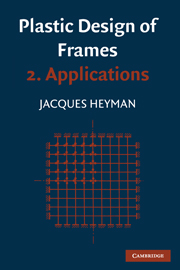7 - MINIMUM-WEIGHT DESIGN
Published online by Cambridge University Press: 05 November 2011
Summary
Most of this chapter will be concerned with the problem of the minimization of the total weight of material in a frame of given geometry acted upon by specified loads. This kind of optimal design is rather restricted. In practice, total material consumption may be of prime importance (as in the design of aircraft, for example); more usually for buildings, it is likely that the total cost of the structure should be made as small as possible. In addition, other criteria, of a somewhat different kind, may be used to determine specific optimal structures; to take one example, depths of beams might be required to be as small as possible for architectural reasons.
However, weight of material is a parameter which can be handled fairly simply in the structural equations, and at the same time in reasonably general terms; the difficulties are avoided of specifying details of the relative costs of shop and site welding, cost of transport, penalties for the variation of cross-section from member to member, and so on. Further, a minimum weight for a frame provides one absolute base for the designer, who is thus able to compare any practical design against the theoretical minimum.
It is for these reasons that minimum-weight design, rather than optimal design for other criteria, has received most attention in the development of plastic theory.
- Type
- Chapter
- Information
- Plastic Design of Frames , pp. 167 - 220Publisher: Cambridge University PressPrint publication year: 1971



